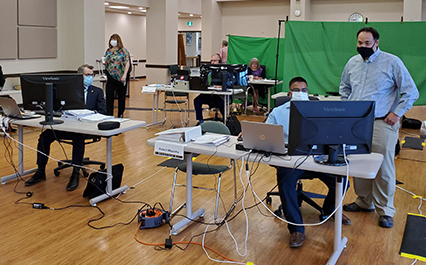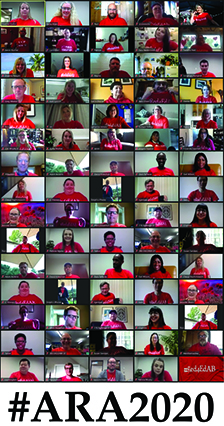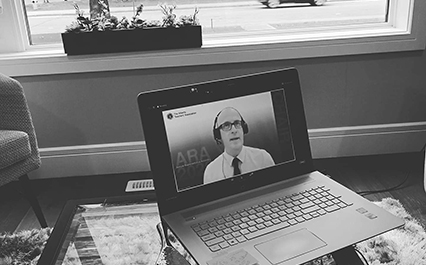Page Content
Behind the scenes of the ATA’s first virtual ARA
The ATA’s 103rd Annual Representative Assembly took place Aug. 13 and 14 via Zoom. It was the first time in the organization’s history that the event (the ATA equivalent of an annual general meeting) did not take place in person.
Event planners started testing processes with Bargaining Unit General Meetings throughout the province in May and June. Various pieces of the process and technology received dry runs in July and early August. During the two-day event, just like every year, delegates spent dozens of hours discussing and debating dozens of issues.

|
|
Face masks, green screens, and computers set up at physically distanced stations were the norm at Barnett House for ARA 2020.
|
While it was not the same as an in-person ARA, I think the key goals were met: delegates were able to debate, amend and vote on resolutions and the budget. It felt like ARA.
– Sharon Vogrinetz, moderator and organizer
|
“It was extremely complex,” said organizer and moderator Sharon Vogrinetz. “There were a lot of moving parts and some decisions had to be made on the fly to address issues as they arose.”
Virtual reality
The first priority for ARA organizers was to ensure that, in a virtual world, ARA still functioned in a legal and transparent manner that allowed delegates to engage in the business of the Association.
Within the Zoom Webinar platform that was used, registered voting delegates were kept separate from others like staff and observers by designating them as “attendees” and others as “panellists.” Panellists did not have access to certain features like voting hands.
Virtual vs in-person ARA – how it works
|
Virtual
|
|
In-person
|
|
When they wish to speak, delegates raise their virtual hand. The moderator notes the delegate’s number, notifies the chair who is next in the queue and activates their microphone. The chair then recognizes the delegate.
|
|
Microphones are strategically placed throughout the ballroom. Whenever a delegate wishes to speak, they stand at a microphone, where they will be noticed and officially recognized by the chair.
|
|
Delegates vote by raising their virtual hands in the Zoom platform. The program automatically tallies the number of votes that are registered.
|
|
Delegates vote by raising the coloured card that they are issued upon registration. The chair assesses whether a vote is won (the yeas win) or lost by estimating which option drew the greater number of cards.
|
|
Staff mark down the number of yeas, then the number of nays. There is no need for division of the house since all votes are accurately counted from the outset.
|
|
If there’s any doubt, someone calls for division of the house. Delegates vote again and staff members physically count the number of cards being held in the air.
|
|
In Zoom, when a delegate votes, a blue hand appears beside their name, so individual votes are visible to all delegates, as are the number of hands being raised, thereby mimicking the experience of being in the room during an in-person ARA.
|
|
Delegates in the room can see how their colleagues are voting and which way the vote appears to be going by the number of cards being held up by those for and those against each resolution.
|

|
|
A compilation of delegates from Edmonton Public Local No. 37.
|

|
|
Submitted by Sturgeon Local No. 27
ATA president Jason Schilling appears on a delegate’s screen during ARA 2020.
|

|
|
Jonathan Sharek of Edmonton Catholic Local No. 54 attends ARA from his home.
|
